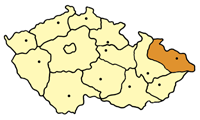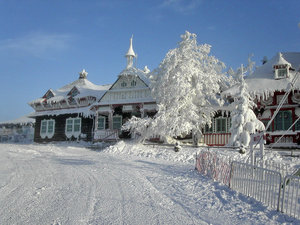Moravian-Silesian Region
|
|
| Statistics | |
|---|---|
| Capital: | Ostrava |
| Area: | 5,445 km² |
| Population: | 1,255,910 (2004) |
| Pop. density: | 231 inh./km² |
| ISO 3166-2: | CZ-MO | Map |
 | |
Moravian-Silesian Region (in Czech Moravskoslezský kraj) is an administrative unit (kraj) of the Czech Republic, located it the north-eastern part of its hitorical region of Moravia and in most of the Czech part of the historical region of Silesia. The region borders the Olomouc Region (to the west) and Zlín Region (to the south). It also borders two other countries - Poland to the north and Slovakia to the east.
It is a very industrial region, which was called the "Steel Heart of the Country" in the communist era, for its prevalence of heavy industry, especially steel works. Since the fall of the communism these industries have been in decline and the region suffers from high unemployment. There are, however, several mountainous areas in which the landscape has preserved its natural character.
Nowadays, the region benefits from its location on the boundaries with two other Central European countries, Poland and Slovakia.
| Contents |
Geography
Overview
The geography of the region varies considerably and comprises many types of landscape from lowlands, to high mountains whose summits lie above the tree line.
In the west lie the Hrubý Jeseník mountains (sometimes named just Jeseníky), with the highest mountain of the region (and all Moravia), Praděd (1491 m). The mountains are heavily forested, with a lot of spectacular places and famous spas (Karlova Studánka, Jeseník) and are therefore very popular with tourists. There are also several ski resorts (e.g. Červenohorské sedlo, Ovčárna) with long-lasting snow cover. The Hrubý Jeseník mountains slowly merge into the rolling hills of Nízký Jeseník (with the highest mountain Slunečná at 800 m) and Oderské vrchy (Fidlův kopec, 680 m).
To the east, the landscape gradually descends into the Moravian Gate (Moravská brána) valley with the Bečva and Odra rivers. The former flows to the south-west, the letter to the north-east, where the terrain spreads into the flat Ostrava and Opava basins (Ostravská a Opavská pánev), where most of the population lives. The region's heavy industry (which has been in decline for the last decade) is located there too, benefiting from huge deposits of hard coal. The confluence of the rivers Odra and Malše is the lowest point of the region, at 195m.
To the south-east, towards the Slovakian border, the landscape sharply rises into the Moravskoslezské Beskydy mountains (often referred to just as Beskydy), with its highest mountain Lysá hora (i.e. Bald Mountain) at 1323 m, which is considered to be the place with the highest annual rainfall in the Czech Republic (around 1500 mm). The mountains are heavily forested and serve as a holiday resort (e.g. Pustevny, Bílá) for the industrial north.
Nature Conservation
Czechia_Praded.jpg
There are three large Landscape Protected Areas (Chráněné krajinné oblasti, CHKO) and a number of smaller nature reserves in the region. Countryside more affected by humans, yet still scenic is protected in five Nature Parks (Přírodní parky).
The CHKO Jeseníky (with an area of 745 km²) lies in the mountain range of the same name in the north east of the region. The terrain is very diverse, with steep slopes and deep valleys. 80% of the area is forested, mostly by secondary plantations of Norway spruce, which were seriously damaged by industrial emissions. Due to local weather conditions, the tree line in the area descends to 1200-1300m. Alpine meadows can be found in particularly low elevations in the Jeseníky. There are also a few peat moors, which are otherwise non-existent in Moravia.
The CHKO Poodří (81.5 km²) lies in the Moravian Gate, in the proximity of the region's capital Ostrava, on the banks of the meandering Odra. It is an area of floodplain forests (one of the last preserved in Central Europe), flooded meadows and a lot of shallow ponds, on which water birds thrive.
The CHKO Beskydy (1,160 km²) is the largest Czech CHKO. It lies in the south-east of the region, along the Slovakian boundary. In the north, the mountains rise steeply from the Ostrava basin, to the south their elevation and severity decreases. Most of the area is forested, mainly by Norway spruce plantations, which are not indigenous to the area. Many of these were severely damaged by emissions from the Ostrava industrial region. There are, however, also a lot of either newly planted or preserved woods of European beech, which in past covered most of the mountains. The CHKO is typical by its mosaic of forests and highland meadows and pastures with hamlets scattered throughout all the mountains. In recent years, bears and wolves have been sighted.There are altogether 125 small protected nature areas covering an area of 52 km². The most notable of them is the lime Cave of Šipka (Jeskyně Šipka) near Štramberk, where remnants of a Neanderthal man were discovered in the late nineteenth century.
Places Of Interest
Stramberk.jpg
There are three towns with protected historical centers. Příbor, the birthplace of Sigmund Freud, was an important center of education for north Moravia from the 17th to the first half of the 20th century. Nový Jičín, founded under the castle of Starý Jičín, has a well preserved central square, nearby is the Žerotínský château, dating back to the 14th century. Štramberk is a unique small town nestled between lime hills with a lot of timbered houses and the spire of Štrúba on a hill above the town.
There are a lot of châteaux in the region, most famous are Hradec nad Moravicí, Raduň, Kravaře, Fulnek. Hukvaldy in a village of the same name under the Beskydy mountains is one the region's many castle ruins, known for its musical feast dedicated to the composer Leoš Janáček, who was born there. Another well-known castle ruin is Sovinec under the Jeseníky.
Due to the importance of industry in the region, there are many museums displaying products of local technical development: The Automobile Museum in Kopřivnice (Tatra car manufacturer), Train Car Museum in Studénka, Mining Museum and the former Michal Mine (Důl Michal) in Ostrava and many others.
Population
The total population of the region was 1,262,660 (men 48.83%, women 51.20%) in 2002, which makes it the most populous kraj of the Czech Republic. 86.9% of them are Czechs, 3.3% Slovaks, 3.0% Poles, 2.3% define themselves as Moravians and 0.8% as Silesians, there also live 0.3% of Germans and 0.2% of Roma (this figure might be much higher as the Roma often do not officially admit their nationality), 40.2% of the population are religious (mostly Roman-Catholic), 52.3% declare themselves atheists.
The population density is 227.3 inhabitants per km², which is the second highest in the country, after the capital Prague (Praha). Most of the population is urban, 62% live in towns with over 20,000 inhabitants.
Administrative Division
Overview
The region was shortly referred to as Ostravský kraj (after its capital Ostrava) but since 2001 this name is officially obsolete.
It is now subdivided into 22 Municipalities with Extended Competence (as the official name goes, in Czech it is Obce s rozšířenou pravomocí) which are sometimes referred to as "small districts" (malé okresy). They are: Bílovec, Bohumín, Bruntál, Český Těšín, Frenštát pod Radhoštěm, Frýdek-Místek, Frýdlant nad Ostravicí, Havířov, Hlučín, Jablunkov, Karviná, Kopřivnice, Kravaře, Krnov, Nový Jičín, Odry, Opava, Orlová, Ostrava, Rýmařov, Třinec and Vítkov.
There are 302 municipalities, of which there are 39 towns, 16 with population over 10,000 inhabitants and 5 towns with over 60,000. These are the capital of the region Ostrava (314,102 in 2002), Havířov (85,271), Karviná (61,146), Opava (60,731) and Frýdek-Místek (60,603).
History
During the communist era of Czechoslovakia (more precisely until 1991), the current region did not exist as such but was only a part of a larger administrative unit called the North Moravian Region (Severomoravský kraj). 6 of its districts (okresy), Bruntál, Frýdek-Místek, Karviná, Nový Jičín, Opava and Ostrava, were in 2001 put into the newly established Moravian-Silesian Region, when they ceased to exist.
External links
- Official website (http://www.kraj-moravskoslezsky.cz)
- Region statistics (http://www.czech.cz/index.php?section=1&menu=5&action=text&id=148)
| Regions of the Czech Republic | 
|
|---|---|
| Carlsbad | Central Bohemia | Hradec Králové | Liberec | Moravia-Silesia | Olomouc | Pardubice | Plzeň | Prague | South Bohemia | South Moravia | Ústí nad Labem | Vysočina | Zlín |
de:Moravskoslezský kraj et:Morava-Sileesia maakond eo:Moravia-Silezia Regiono nl:Moravisch-Silezische Regio ro:Regiunea Moravia-Silezia sk:Moravskosliezsky kraj

